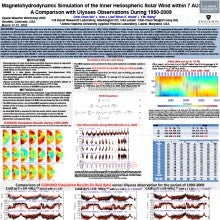Magnetohydrodynamic Simulation of the Inner Heliospheric Solar Wind within 7 AU: A Comparison With Ulysses Observations During 1990-2009
Chin-Chun
WU
US Naval Research Laboratory, Washington D. C. , USA
Poster
The purpose of this work is to test the performance of the G3DMHD model [Wu et al., 2020, 2024]. G3DMHD is a data driven, time-dependent, global 3-D magnetohydrodynamic (MHD) model. The model has been proven to be effective in simulating the solar wind at and within 1 AU using the solar wind data from Wind and Parker Space Probe. In this work, we extend the G3DMHD model simulation domain out to 7 AU and perform three simulations. The simulated solar winds are compared with the Ulysses observations. Ulysses was the first (and still the only) spacecraft to orbit the Sun with a high inclination angle (~80º ), monitoring the solar wind from pole to pole. Therefore, its data provide a stringent test of the G3DMHD model. Specifically, we use a sequence of source surface (2.5 R⊙) maps, which are extrapolated from the (Mount Wilson Observatory) photospheric magnetic field maps using the potential field model, from 1990 to 2009 continuously covering two solar minima (1996 & 2008) and one solar maximum (2000), to drive G3DMHD. We consider the following three different inner boundary conditions: Case-A: Vr = 150 +500 fs km/s and γ = 1.67; Case-B: Vr = 150 +650 fs km/s and γ = 1.46; and Case-C: Vr = 150 +650 fs km/s and γ = 1.30, where Vr is the radial speed at 18 R⊙, γ is the specific heat ratio, and fs is expansion factor. After comparing with the Ulysses observations (density, speed, temperature and magnetic intensity), the following results are found: (a) None of the three cases can lead to a satisfactory result for the four solar wind plasma and field parameters for all region/period being considered; (b) the solar wind speed is under-estimated in the pole region during solar minima for Case-A; (b) the solar wind temperature is under-estimated for Case-A for the entire time period and Case-B in solar minima; is over-estimated during 1997-2001 for Case-C; (c) the solar wind speed is over-estimated in solar maximum (2000) for both Case-B & Case-C; (d) the Case-C results in a better agreement for both solar wind density (Pearson correlation coefficient (cc) = 0.58; mean absolute squared error (MASE) = 0.64) and the solar wind velocity (cc = 0.56; MASE = 0.75) than for the solar wind magnetic intensity (cc = 0.40; MASE = 1.97) and temperature (cc = 0.38; MASE = 1.28). This simulation work suggests that the initial solar wind speed at the inner boundary, which is still difficult to measured, plays an important role. It is also suggested that a proper heating (controlled by γ) in the solar wind will need to be considered.

Poster PDF
Poster category
Space Weather Policy and General Space Weather Contributions
Meeting homepage